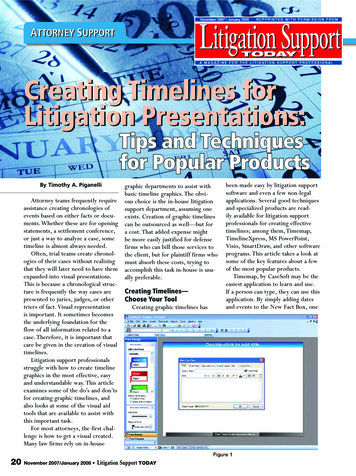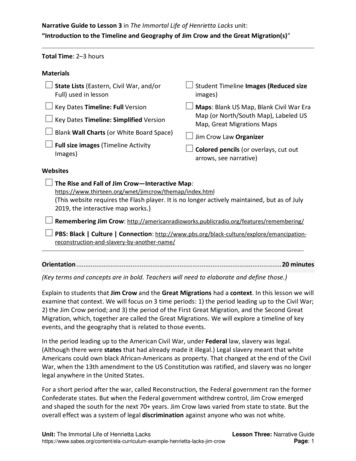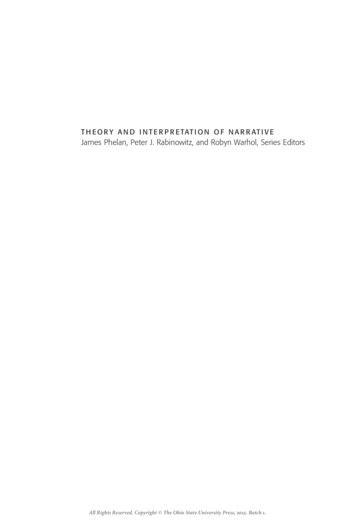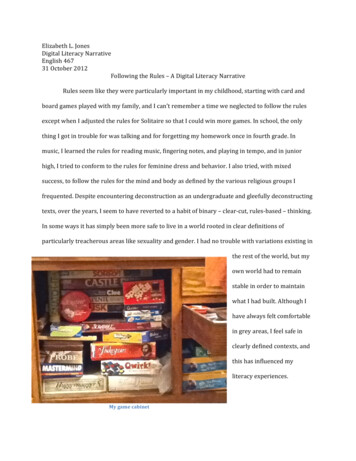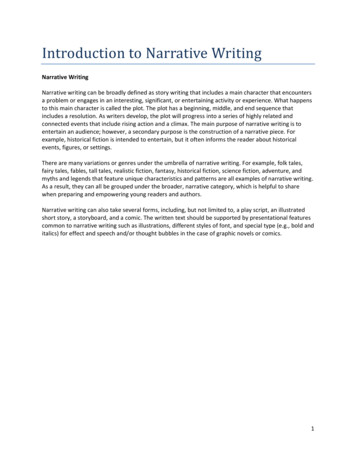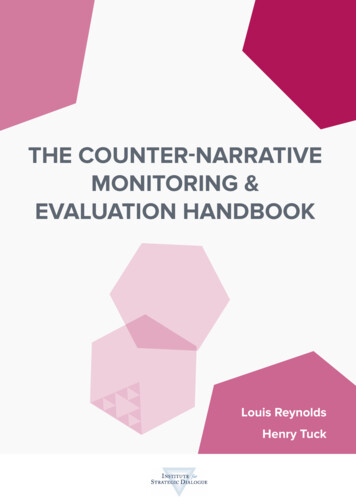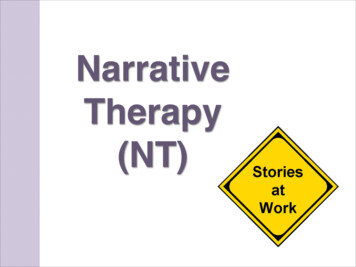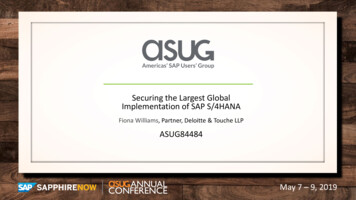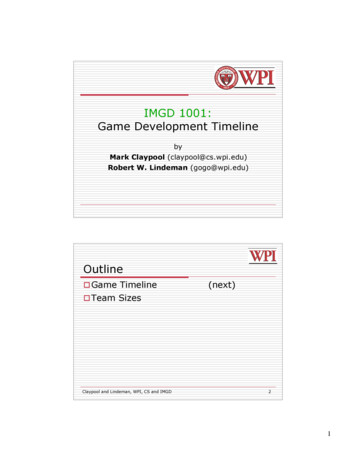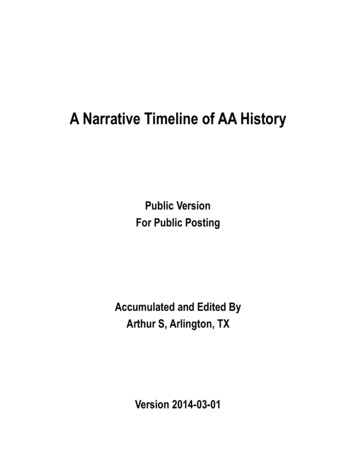
Transcription
A Narrative Timeline of AA HistoryPublic VersionFor Public PostingAccumulated and Edited ByArthur S, Arlington, TXVersion 2014-03-01
Narrative Timeline of AA HistoryImportant Notice and AppealThis document exists in two forms: one marked “Confidential” and the other marked “Public.” The “Confidential” version has the last names of AA and Al-Anon members. It should not be posted on apublicly accessible web site or distributed to the public at large. It is intended solely for distribution to AAmembers and individuals engaged in serious AA history research. The “Public” version shows last initials in place of last names except for those AA and Al-Anon memberswhose identity is well established in the public domain. It may be distributed freely. Under no circumstances should either version be sold or intermingled with other sold material. They areintended to be freely given away as an AA history research and education tool.Fair UseAA, Alcoholics Anonymous, The Big Book, Box 459, The Grapevine, GV, Box 1980 and La Viña are registeredtrademarks of Alcoholics Anonymous World Service (AAWS) Inc or AA Grapevine Inc.Publication of this document does not denote nor imply affiliation with, approval by, or endorsement from,Alcoholics Anonymous or any part of its worldwide service structure. The narrative and any errors containedin this document are the sole responsibility of the author.Single-use excerpts from AAWS and AA Grapevine publications and archives documents are cited under thegood faith and fair use provisions of US copyright statutes for purposes of criticism, comment, scholarshipand research.The reader is urged to review an illustrated timeline of AA history developed by GSO Archives accessible atthe AA.org website. The website also offers the download of PDF files of past issues of Box 4-5-9 and theGSO Archives newsletter “Markings.”A number of other reputable and source-rich websites are identified as well in this document as exceptionaldigital AA history repositories.March 1, 20142 of 134Public Version
Narrative Timeline of AA HistoryForewordAA Members seem to have a warm place in their heart for AA history. The AA Fellowship also has a strongverbal tradition. Much information is passed on by word of mouth. This has both its good and difficult sides.It begs the question “how much narrative is fact and how much is myth or error?” History is not supposed tobe statements of beliefs; it is supposed to be statements of facts.Much anecdotal myth circulates in AA and is erroneously accepted as fact. Myths unfortunately assume theaura of facts when frequently repeated. Inaccurate statements such as “Dr Bob sobered up on June 10, 1935”or “no changes have been made to the wording of the Big Book basic text” permeate AA. The popular adagethat “repetition strengthens and confirms” certainly applies to practicing AA principles. Unfortunately, it alsoapplies to making myths and errors appear to be facts.The objective of this timeline document is to aid those engaged in AA history research and study. Much efforthas been taken to ensure that what is presented has been verified and confirmed in at least one or hopefullymultiple reliable source references. Timeline items are cross-referenced to their source(s) of derivation toprovide both corroboration and external sources for further investigation.Two Excel workbooks complement this document. They contain AA membership and literature distributioncount data mainly derived from final General Service Conference Reports from 1951 to the present: Appx-1: contains annual counts/estimates of AA groups and members. It also includes data from acontemporary GSO service piece “Estimated Worldwide AA Individual and Group Membership” (F-132)as a separate worksheet in the workbook. A PDF version can be downloaded from the AA.org web site. Appx-2: contains annual book distribution counts and royalties reported for the English language versionsof the Big Book, 12&12, AA Comes of Age and As Bill Sees It.Count figures from the above Excel workbooks are cited in this document at the end of each year.For General Service Conferences, the selection of advisory actions included/excluded is based solely on thepreference of the author and a need to pare the voluminous text of advisory actions from 1951 to the present.To the extent possible failed or postponed advisory actions are also included.Most citations from source references are not verbatim and are edited and abridged for brevity (hopefully notat the expense of accuracy). When this is so, it is denoted by the term “(edited).” For verbatim text, the readeris advised to read the source reference document(s).To accurately relate the past to the present, Consumer Price Index (CPI) conversion factors are used toconvert past dollar amounts to the equivalent of 2012-dollar values. For example, 3.50 was needed in 1939to purchase the Big Book. That would be equivalent to 57 in 2012 dollars. Results are shown as “( nnntoday)” and are not rounded.CPI conversion data are derived from the website of Robert C Sahr, PhD of the Political Science Department,Oregon State University, Corvalis (www.oregonstate.edu). An Excel spreadsheet of the CPI conversionfactors may be downloaded from the website and are continuously updated.Arthur S, Arlington, TXMarch 1, 20143 of 134Public Version
Narrative Timeline of AA HistoryTagWeb-Based Digital Repository SourcesAA-orgAA.org - GSO web site - most AA publications are available as downloadable PDF filesAAHLAAhistorylovers - AA history fellowship and email repository @yahoo.com (Glenn C)Gv-orgAAgrapevine.org - AA Grapevine web site (subscription service for digital archives)HF-orgHindsfoot.org - Hindsfoot Foundation AA history repository (Glenn C)LoCLOC.gov - Library of Congress digital collectionsNARAArchives.gov - National Archives and Records Administration (NARA)SW-netSilkworth.net - AA history repository (Jim M)WBG-comA-1associates.com/aa/ - AA history repository of the W Baltimore Group (Al W)WikiWikipedia.org - research encyclopediaWWP-comWilliamWhitepapers.com - digital archives collection of William L WhiteWWWWWW - web search (usually derived from Google and/or Bing)TagDigital Source ReferencesAAEB-m-yAA Exchange Bulletin (month and year) - pre-Box 4-5-9, accessible via AA-orgAppx-1Appendix 1: Counts of AA Groups and Members (Excel spreadsheet)Appx-2Appendix 2: Book Royalties Distributed (Excel spreadsheet)B459-m-yBox 4-5-9 (month and year) accessible via AA-orgGSC-yGeneral Service Conference final report (year) - by AAWS/GSO - marked confidentialGSO-ACGeneral Service Office Archives Collection - photocopiesGv-m-yGrapevine (month and year) accessible via Gv-orgMark-i-nMarkings GSO Archives Newsletter (issue and number) accessible via AA-orgMarch 1, 20144 of 134Public Version
Narrative Timeline of AA HistoryTagSource Reference Books and Authors12&12Twelve Steps and Twelve Traditions by Bill W, accessible via AA-orgAACOAAlcoholics Anonymous Comes of Age by Bill WABSIAs Bill Sees It by Bill WAGAAThe Akron Genesis of Alcoholics Anonymous by Dick BBBAlcoholics Anonymous (the “Big Book”) by Bill W et al - accessible via AA-orgBW-RTBill W by Robert ThomsenBW-FHBill W by Francis HartiganBW-40Bill W My First 40 Years - autobiographyCHChildren of the Healer, Bob Smith and Sue Smith Windows by Christine BrewerDBGODr Bob and the Good Old-timers by AAWSEBBYEbby the Man Who Sponsored Bill W by Mel BGBGetting Better Inside Alcoholics Anonymous by Nan RobertsonGTBTGrateful to Have Been There by Nell WingHIWHow It Worked by Mitchell KHTHarry Tiebout - the Collected Writings, Hazelden Pittman PressLOHThe Language of the Heart - a collection of historical Grapevine articles by Bill WLRLois Remembers by Lois WilsonLWSThe Lois Wilson Story When Love Is Not Enough by William G BorchertMMMMrs Marty Mann by Sally and David R BrownMSBWMy Search for Bill W by Mel BNGNot God by Ernest KurtzNHBPNon-approved history of AA by Bob P (2-column reproduction for page numbering)NWNew Wine by Mel BPIOPass It On by AAWSRAAThe Roots of Alcoholics Anonymous by Bill Pittman (nee AA the Way It Began)SISister Ignatia by Mary C DarrahSDSlaying the Dragon by William L WhiteSMAA Service Manual & 12 Concepts for World Service by AAWS - accessible via AA-orgSWSilkworth - the Little Doctor Who Loved Drunks by Dale MitchellWPRWomen Pioneers in 12 Step Recovery by Charlotte Hunter, Billye Jones and Joan ZieglerSource references typically show an identifier “Tag” followed by page number(s), e.g.PIO 111, 113 references “Pass It On” pages 111 and 113PIO 170-175 references “Pass It On” pages 170 thru 175March 1, 20145 of 134Public Version
Narrative Timeline of AA HistoryOrigin of the Word “Alcohol”The word “alcohol” derives from the Arabic “al-kuhul” a term applied to the chemical compound ethyl alcoholor ethanol. The Arabic term denotes “kohl” a fine powder of antimony used as eye makeup. In its earliestusage, the word “alcohol” denoted any fine powder. Alchemists of medieval Europe later applied the word toessences obtained by distillation. It was not until the 18 th century that the word came to designate theintoxicating ingredient in liquor. (SD xiv, WWW, Wiki)1700s1774 - The earliest American writing on alcoholism was authored by Anthony (Antoine) Benezet ofPhiladelphia, PA, an abolitionist and temperance advocate. It was a 48-page essay titled“MIGHTY DESTROYER DISPLAYED in some Account of the Dreadful Havock made by the mistaken Useas well as Abuse of DISTILLED SPIRITUOUS LIQUORS.”At this point in time, the word “temperance” was often used to encourage moderation in drinking and laterevolved into “teetotalism” which advocated total abstinence. (SD 4-5, WWW, Wiki)1784 - Philadelphia physician and Revolutionary War patriot, Dr Benjamin Rush, was the first Americanphysician to describe alcoholism as a disease. Rush was a member of the Continental Congress, signer ofthe Declaration of Independence and Surgeon General of the Army during the American Revolution andfounder of Philadelphia Medical College. He is often called the father of American psychiatry and father ofthe American temperance movement. In a 36-page paper titled “An Enquiry into the Effects of Ardent Spiritson the Human Body and Mind” he described habitual drunkenness as a “progressive and odious disease”and that total abstinence “suddenly and entirely” was the only effective treatment. (GB 43, 168, GSC-1996,SD 1-5, WWW, Wiki)1790s - The birth of the newly formed republic of the United States began with an accompanying alcoholbinge of major proportion. The period from the early 1790s to 1830s marked the highest per-capita level ofalcohol consumption in US history. Many factors contributed to the surge: (1) Drinking preferences shiftedfrom beer and wine to distilled liquor. (2) Absent hard currency, distilled liquor was often used as legal tenderin payment for goods, services and taxes. (3) It was common practice, at the time, for employers to providetheir workers (which included children) with daily rations of distilled liquor as part of their pay. (4) Physiciansfrequently prescribed alcohol for a wide variety of ailments. (5) Alcohol also served as a dietary staplebecause supplies of other beverages were erratic and water supplies were often polluted. (SD 1-5, WWW)1790s - Prominent historical figures, such as George Washington, Thomas Jefferson, Benjamin Franklin andJohn Adams (whose son Charles was an alcoholic) called for a change in national drinking practices. Theyappealed to the country for moderation in drinking. (SD 4-5, WWW)1794 - Thousands of Pennsylvanian farmers took up arms and openly rebelled against a federal excise taxon distilled spirits promulgated by Alexander Hamilton the first US Secretary of the Treasury. Known as the"Whiskey Rebellion" it was the largest organized resistance against federal authority between the time-spanof the American Revolution to the Civil War. President George Washington led a militia of 13,000 to suppressthe uprising. Opposition collapsed prior to arrival of the militia and the tax was continued. (WWW)1797 - At the recommendation of his plantation manager, George Washington established the largest USdistillery at that time. In 1798, a year before Washington’s death, it produced 11,000 gallons of whiskey anda profit of 7,500 ( 140,000 today). (WWW)March 1, 20146 of 134Public Version
Narrative Timeline of AA History1800s1810 - Dr Benjamin Rush called for the creation of “sober houses” where alcoholics could be confined andrehabilitated. This was the forerunner of Treatment Centers. (GB 43, 168, GSC-1996, SD 1-4)1830s - The average American, aged 15 or older, consumed over seven gallons of absolute alcohol a year(about three times the contemporary rate). Religious and political leaders viewed drunkenness as a nationalcurse. Momentum was picked up by religious leaders to change the notion of “temperance as moderation” tomean “temperance as abstinence.” It began the growth of the American temperance societies that later ledto the alcohol prohibition movement. (SD 4-5, WWW, NARA)1840 - April 5, a group of six drinking club friends (William Mitchell, John Hoss, David Anderson, GeorgeSteers, James McCurley and Archibald Campbell) formed a total abstinence society. Pledging “not to drinkany spirituous or malt liquors, wine or cider” they named themselves the “Washington Temperance Society”also known as the “Washingtonian Total Abstinence Society” (in honor of George Washington). Theyeventually became known simply as “Washingtonians.” They required a pledge of total abstinence andattendance at weekly meetings where members would tell their stories of drunkenness and recovery. As abody, they recognized no religion or creed and were politically neutral. Each member was supposed to helpalcoholics who were still drinking and seek out new prospects (“hard cases”). The weekly meetings were heldat Chase’s tavern on Liberty St in Baltimore, MD until the owner’s wife objected to the increasing loss of theirbest customers. They had a 25-cent initiation fee ( 7 today) and monthly member’s dues of 12 1/2 cents( 3.50 today). (SD 8-9, WWW, 1950 Milton Maxwell paper)1840 - November 19, the Washingtonians held their first public meeting. Their membership growth was quiterapid claiming 200,000 members by 1841 with widespread and enthusiastic support from numeroustemperance societies. The Washingtonians had great success in mobilizing public attention on temperanceby relaying their “experience sharing” of alcoholic debauchery followed by glorious accounts of personalreformation. A leader of the movement noted, “There is a prevalent impression, that none but reformeddrunkards are admitted as members of the Washingtonian Society. This is a mistake. Any man may becomea member by signing a pledge and continue so by adhering to it.” (SD 9, WWW, 1950 Milton Maxwell paper)1841 - May 12, the first organized “Martha Washington Society” meeting for women and children was held inNY to provide moral and material support to reform female inebriates and assist the wives and children ofmale inebriates. It was the first temperance movement in which women assumed leadership roles. It alsospawned juvenile auxiliary groups. Freed blacks organized separate Washingtonian societies. (SD 10)1842 - February 22, Abraham Lincoln spoke to the Springfield, IL Washingtonians. He praised their movementand criticized earlier temperance movements that defined alcoholics as incorrigible. Lincoln commented, “Ibelieve if we take habitual drunkards as a class, their heads and their hearts will bear an advantageouscomparison with those of any other class. There seems ever to have been proneness in the brilliant andwarm-blooded to fall into this vice.” Lincoln is also quoted as saying that liquor was “used by everybody,repudiated by nobody” and that it came forth in society “like the Egyptian angel of death, commissioned toslay if not the first, the fairest born in every family.” (SD 9, GSO-AC, GSC-1996, WWW)March 1, 20147 of 134Public Version
Narrative Timeline of AA History1843 - Mid-to-end, the Washingtonian movement peaked after having reached all major areas of the US.Membership estimates vary and are contradictory. The sole requirement for membership was to sign a “totalabstinence pledge.” Members included teetotalers, temperance advocates and a large segment ofadolescents (under age 15) and drinkers of various types whose numbers far exceeded that of the“drunkards.” A reliable estimate of the number of alcoholics in the mix is impossible to derive. Over the lifetimeof the movement, hundreds of thousands (some estimate 600,000) signed pledges but the number ofrehabilitated alcoholics was likely under 150,000. (GSC-1996, SD-10, WWW, 1950 Milton Maxwell paper)1847 - Estimate of when the Washingtonians “spent its force” and began its demise. The society originallyfavored “moral suasion” to reform alcoholics through abstinence. As their membership changed, rapidly andradically, to consist mainly of non-alcoholic temperance supporters, attitudes shifted away from reformationto pursuit of a legal means to prohibit alcohol. Washingtonian practices were viewed as outmoded and interestin them waned. There was no sudden or massive collapse. When the novelty and emotional appeal of theWashingtonians became outmoded, they simply faded from the scene over time. Some cite issues such asreligion, politics and advocating abolition of slavery as root causes of the Washingtonian decline. While therewere cases of this, there is no compelling evidence to conclude that these issues were predominant in theirdecline. Prohibition was a very divisive issue within the Washingtonians. However, the major causes of theirdownfall appear to result from their departing from their original membership makeup (which began as allalcoholics) and departing from their original primary and single purpose (which started out as one alcoholichelping another alcoholic). It is a powerful lesson on the vital importance of AA’s Traditions. (SD 8-14, 12&12176-179, AACOA 124-125, PIO 366-367. WWW, 1950 Milton Maxwell paper).1849 - Swedish physician Magnus Huss coined the word “alcoholism” in writings titled “Chronic Alcoholism”(“Alcoholismus Chronicus”) and “Chronic Alcohol-Sickness“ (“Chronische Alkohols Krankheit“). Huss usedthe term to describe a state of chronic alcohol intoxication that included both the destructive action of alcoholon the human system and a diseased condition produced by alcohol. It took nearly a century (mid-1900s) forthe terms “alcoholism” and “alcoholic” to achieve widespread usage in America. (GB 167-168, SD xiv)1852 - The term “skid row” allegedly stems from a section of Seattle, WA. A sawmill built in Pioneer Squarenear Puget Sound used skids (or tracks of peeled logs) to drag timber to the mill. The area became home tovagrants and destitute alcoholics. It was first known as “Skid Road” and later as “Skid Row.” The term waslater picked up by the national press to describe blighted city areas frequented by chronic alcoholics. It is stillused in cities today such as Los Angeles whose Skid Row population is an estimated 12,000. (SD 72, WWW)1862 - Charles B Towns was born on a small farm in central GA. (RAA 84)1864 - Bill W’s great uncle, Waldow Barrows, was killed in the Civil War Battle of the Wilderness. (PIO 54)1865 - Bill’s grandparents, William C Wilson and Helen Barrows, were married. (RAA 136)1870 - Bill’s father, Gilman (Gilly) Barrows Wilson, and mother, Emily Griffith, were born. (BW-RT 12)1872 - October, ex-convict Jerry (Jeremiah) McAuley, and his wife Maria, opened a rescue mission called“The Helping Hand” at 316 Water St in the notorious fourth Ward of NY City. It marked the beginning of theurban mission movement. Rescue missions were later spread across America by the Salvation Army andfocused primarily on Skid Row alcoholics. When McAuley died (in 1884), he was succeeded by SamuelHopkins Hadley whose example of recovery from alcoholism was cited in William James’ book “The Varietiesof Religious Experience.” (SD 77-74, WWW)1873 - July 22, William Duncan Silkworth (“the little doctor who loved drunks”) was born in Brooklyn, NY toIsabelle Duncan and William Silkworth Sr. (SW 3)March 1, 20148 of 134Public Version
Narrative Timeline of AA History1877 - Carrie (sometimes-spelled Carry) Amelia Moore Nation was an American temperance leader and quitea character. At age 21, she married physician Charles Gloyd who was an alcoholic. Her efforts to reform himfailed and he died of his alcoholism shortly after their marriage. She later married David Nation, 19 years hersenior, eventually settling in Medicine Lodge, KS where she responded to what she believed was a divinecalling to destroy saloons. Nearly six feet tall and dressed as a deaconess, she was an imposing figure andgained national renown for her radical opposition to alcohol. In Wichita, KS, she began using a hatchet toruin saloons, describing them as “hatchetations.” Arrested 30 times for disturbing the peace, funds from herlectures and sales of souvenir hatchets paid for her bail and fines. She published newsletters called“Smasher's Mail” the “Hatchet” and the “Home Defender” which helped pay for a home for wives of alcoholicsin Kansas City, KS. In 1901, her husband divorced her for desertion. (WWW, Wiki)1878 - June 4, Frank (Franklin) Nathaniel Daniel Buchman was born in Pennsburg, PA. (RAA 114, NW 32)1879 - August 8, Robert Holbrook Smith (Dr Bob) was born in St Johnsbury, VT to Judge and Mrs WalterPerrin Smith. He had a much older foster sister, Amanda, who became a history professor at Hunter College,NY. (DBGO 9, 12, 14, CH 2, NG 29-30)1880s - Late, various businesses offering so-called alcoholism “cures” grew at a prolific rate. All-too-often,the remedy prescribed was more dangerous than what it was supposed to fix. Some of these unregulatedbusinesses became so popular that they grew into what we would today call “franchises” or “chains.” Twoprominent chains were the Keeley Institute and the Gatlin Institute. Between 1880 and 1920, more than500,000 alcoholics/addicts took the Keeley Cure that was praised by some as a cure of miraculous potentialand at the same time attacked by others as a fraud. (SD 51-71)1881 - March 21, (sometimes reported as March 3) Anne Smith (nee Ripley) was born to Joseph Ripley andHarriet Konnatz in Moline, IL. They later lived in the Chicago suburb of Oak Park. Anne was one of fourchildren. She had three brothers, two of whom were estranged. Anne grew up in a family of Santa Fe Railroadpeople in a sheltered atmosphere. (CH 16, 105-107, 112)1881 - October 29, Rowland “Roy” Hazard III was born. He was the eldest of five children of Rowland Gibsonand Mary Pierrepont Bushnell Hazard. (WWW)1885 - September, Dr Bob entered the Summer St Elementary School in St Johnsbury, VT. (DBGO 12)1886 - August 29, T Henry Williams was born in South Woodstock, CT. (AGAA 65)1888 - Lois Wilson’s parents, Dr Clark Burnham and Matilda Hoyt Spellman, were married. Openlyaffectionate they loved having the children around for family activities. Born in Lancaster PA, Lois’ father wasa prominent physician and honors graduate from college and medical school. His father Nathan ClarkBurnham was a lawyer and physician and a minister in the Swedenborgian Church that had recently cometo America. He later performed the marriage ceremony of Lois and Bill. Lois’ mother was from an affluentfamily. She managed the business affairs for her husband’s medical practice. Her close cousin Laura wasmarried to John D Rockefeller Sr. (LR-2, LWS *)1888 - March 18, Henrietta Seiberling (nee Buckler) was born in Lawrenceburg, KY to Judge Julius A andMary Maddox Buckler. (AGAA 83)1888 - Summer, Dr Bob (turning 9) had his first drink from a jug of hard cider. (DBGO 13)1889 - January 1, Bridget Gavin (Sister Ignatia) was born in Shanvally, County Mayo, Ireland. (SI 44, 306)1890 - August 15, Elvin (“Bunky”) Morton Jellinek was born in NY. (GB 171)March 1, 20149 of 134Public Version
Narrative Timeline of AA History1891 - March 4, Lois Wilson (nee Burnham) was born at 182 Clinton St in Brooklyn, NY in a spaciousbrownstone in the affluent section of Brooklyn Heights. A back room served as her father’s medical office. Atthis time Brooklyn was a separate city (it became a borough of NY City in 1898). Lois was the eldest of sixchildren then came Rogers, Barbara, Katherine (or Kitty) and Lyman. Lois also had a baby sister Mathildawho was sickly since her difficult birth and who died before she was a year old. Lois’ father ensured that allthe children had the best educations. Lois began her schooling with a new form of pre-school educationimported from Germany that was called “kindergarten.” As a youngster at Emerald Lake in VT, she was quitethe tomboy and loved fishing, swimming, sailing, climbing trees, catching frogs and picking berries duringlong early morning walks. She attended Friends School and Packer Collegiate (an all-girls school) for gradesone through twelve and matured into a brilliant and artistically talented woman. She was a co-founder of AlAnon Family Groups together with her neighbor and friend Anne B. (WPR-54, LWS 11, 17)1893 - December 27, Samuel Moor Shoemaker was born in Baltimore, MD. (WWW)1894 - September, Dr Bob (age 15) entered St Johnsbury Academy. (DBGO 15, GB 34)1894 - September, Bill W’s parents, Emily Griffith and Gilman Wilson, were married. (PIO 13, BW-RT 15)1894 - December, Bill’s uncle, Clarence Griffith, died of tuberculosis in CO. (BW-RT 31, BW-40 25, PIO 28)1895 - November 26, Bill W was born in a room behind a bar in the Wilson House (formerly the BarrowsHouse aka the Mt Aeolus Inn and Tavern) a village hotel run by his grandmother Helen Barrows Wilson. Billwas named after his paternal grandfather, William C Wilson, who was quite prominent in the community.According to Bill’s sister Dorothy, their grandfather was an alcoholic who found sobriety through a profoundspiritual experience while hiking on Mt Aeolus. (BW-RT 15, CH 4, NG 10, PIO 13, 407, RAA 138).1896 - January 2, Harry Morgan Tiebout was born in Brooklyn, NY. (HT vii)1895 - Lois’ maternal grandfather, living in Manchester, VT, encouraged her parents to purchase his home.They later became enamored with a roomy cottage on Emerald Lake in East Dorset, VT. (LWS 20)1896 - April 29, Edwin “Ebby” Throckmorton T was born in Albany, NY. (EBBY 20).1898 - Lois W’s family vacationed at Emerald Lake from May to November each year. It was also a popularvacation spot for Ebby T’s family as well. Over the years of extended summer vacations, the two familiesdeveloped a close friendship. (LWS)1898 - Dr Bob met Anne Ripley in his senior year at St Johnsbury Academy. Anne, a scholarship student atWellesley College, was visiting a friend. It began a 17-year courtship. Anne was small and reserved and hada cheerfulness, sweetness and calm that remained with her throughout her life. (DBGO 16, GB 34, WPR 3)1898 - After graduating from St Johnsbury Academy, Dr Bob entered Dartmouth College. (CH 2, DBGO 348)1898 - Dorothy Brewster Wilson, Bill’s younger sister, was born. Her future husband, Dr Leonard V Strong,played a key role in helping Bill find sobriety and receiving financial assistance from John D Rockefeller Jr tohelp in the writing of the Big Book. (PIO 15)March 1, 201410 of 134Public Version
Narrative Timeline of AA History1900 to 19091901 - The “Charles B Towns Hospital for Drug and Alcohol Addictions” opened in NY City as a private “dryingout” hospital for the affluent. Opening first on 81 st and 82nd Streets, it later moved to 293 Central Park West.Hospital fees had to be paid in advance or be guaranteed and ran from 75 to 150 ( 2,000 to 4,000 today).Towns had no medical background but was a renowned leader and reformer in the treatment of alcoholismand drug addiction. He played a major role in providing financial support to Bill W during the writing of the BigBook and helped arrange much favorable publicity for AA. (SD 84-85, SW 125)1901 - Harvard professor William James presented the “Gifford Lecture Series on Natural Religion” at theUniversity of Aberdeen in Edinburgh, Scotland. His lectures were published in 1902 in a critically acclaimedbook titled “The Varieties of Religious Experience - a Study in Human Nature.” James cited numerousexamples of two styles of spiritual transformation: one gradual and the other sudden and dramatic. Neitherwas considered superior to the other. Thirty-two years after its publication, a copy of the book was given toBill W during his last stay in Towns Hospital. Its influence on Bill and early AA members is cited in the BigBook. James is mentioned twice in the Big Book by name. He is also recognized as the Father of AmericanPsychology. (GB 47, WWW)1901 - Bill W’s mother, Emily, spent much of the year in FL with his sister Dorothy. Bill wrote several lettersasking when she would be returning home. (BW-FH 18)1902 - Dr Bob graduated from Dartmouth. During his school years, drinking was a major activity. In the eyesof the drinking fraternity, he was “summa cum laude.” Dartmouth had a reputation as “the drinkingest of theIvy League schools.” After graduation, Dr Bob went through three years of drifting and selling heavy hardwarein Boston, Chicago and Montreal. (CH 2, DBGO 22, 348, NG 30, RAA 172, GB 34-35)1903 - Bill W’s family moved to 42 Chestnut Ave, Rutland, VT. He attended the Church St School. (PIO 20)1904 - Over time Emily and Gilman Wilson’s marriage was stormy. (BW-FH 12, BW-RT 17)1904 - October 15, Margaret “Marty” Mann was born in Chicago to Lillian Christy and William Mann. (MMM13-16)1905 - September, Bill W’s father, Gilman (after a bitter argument with Emily) took Bill on a late-night buggyride and asked him to take good care of his mother and sister. The next morning Bill’s sister Dorothy told himthat their father had gone away. Pri
Narrative Timeline of AA History March 1, 2014 5 of 134 Public Version Tag Source Reference Books and Authors 12&12 Twelve Steps and Twelve Traditions by Bill W, accessible via AA-org AACOA Alcoholics Anonymous Comes of Age by Bill W ABSI As Bill Sees It by Bill W AGAA The Akron Genesis of Alcoholics Anonymous
